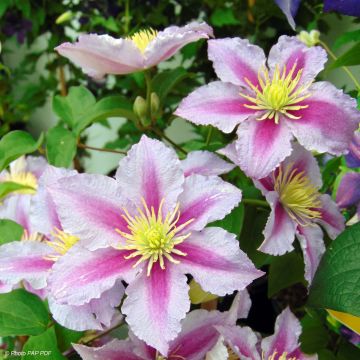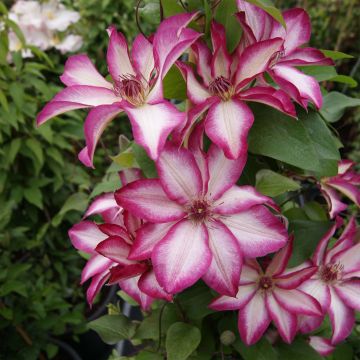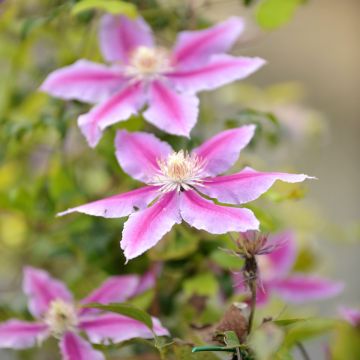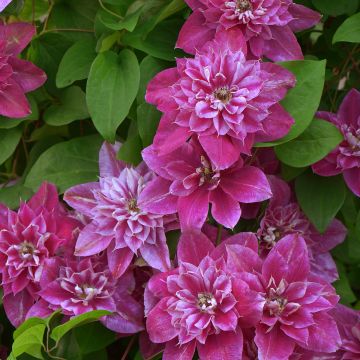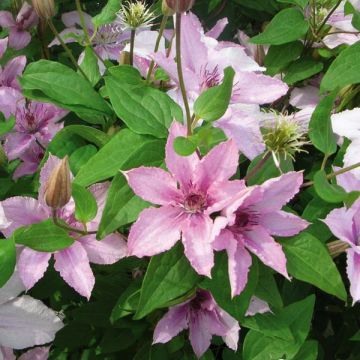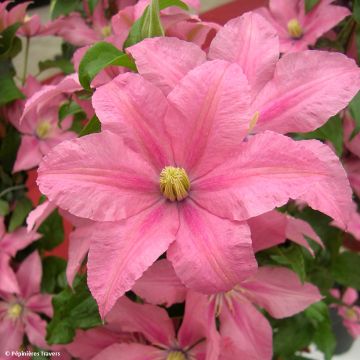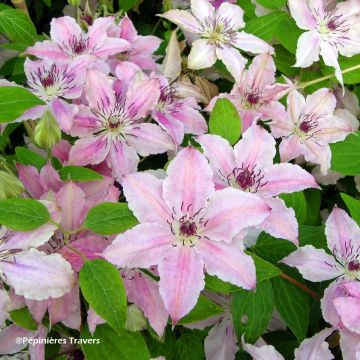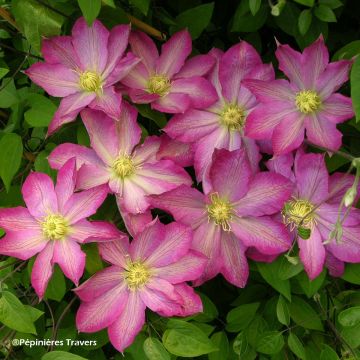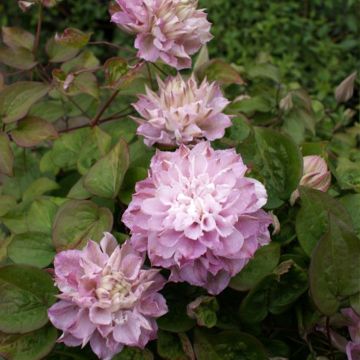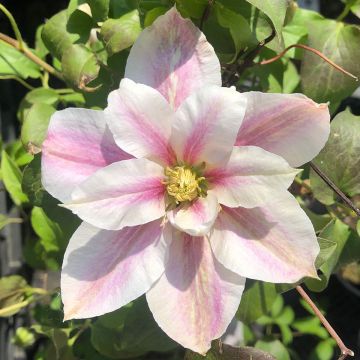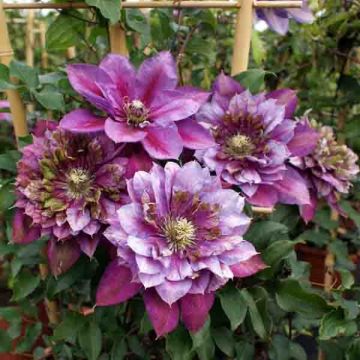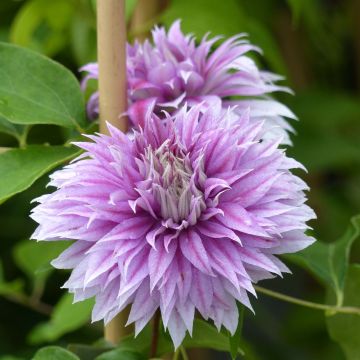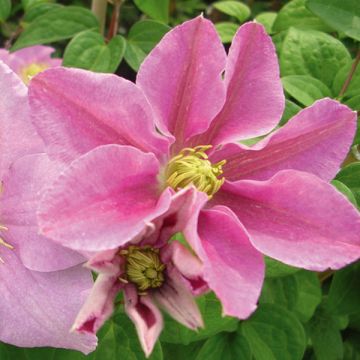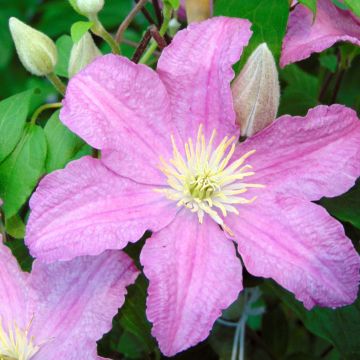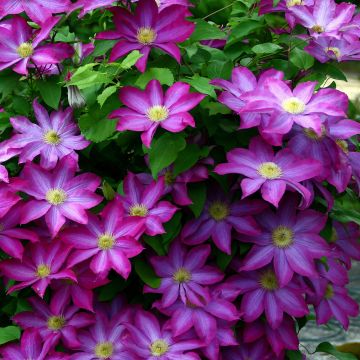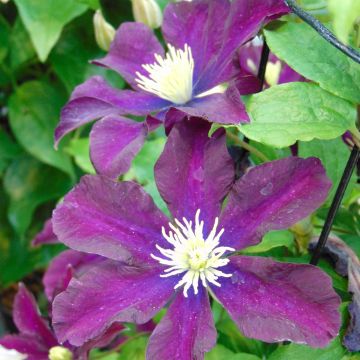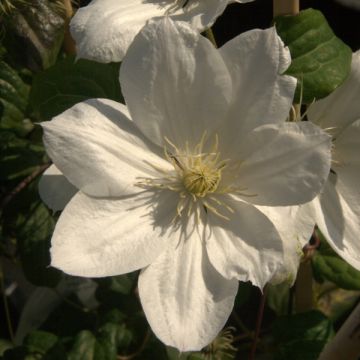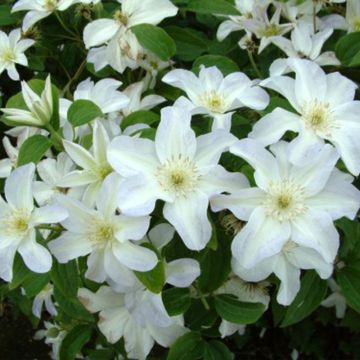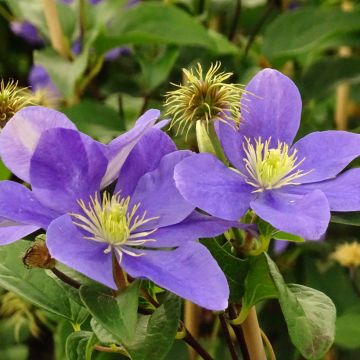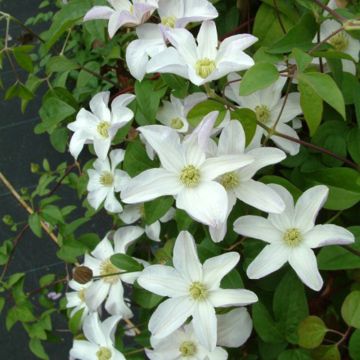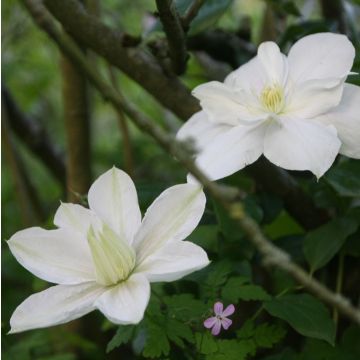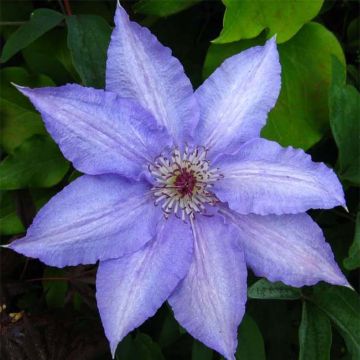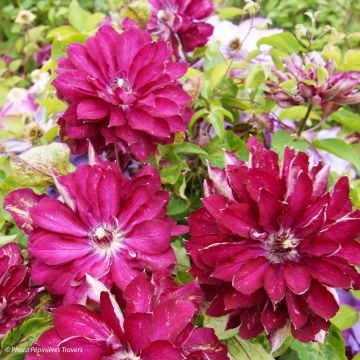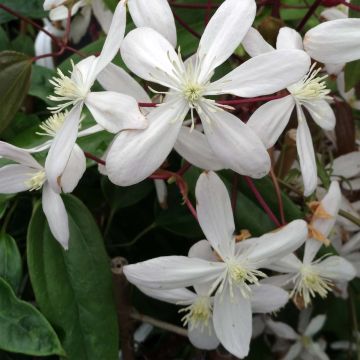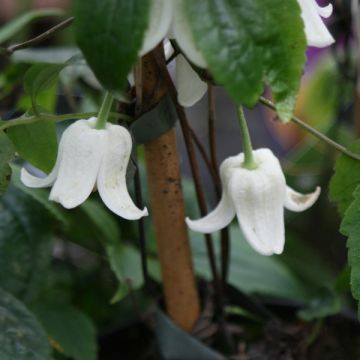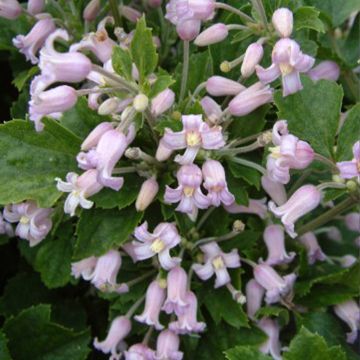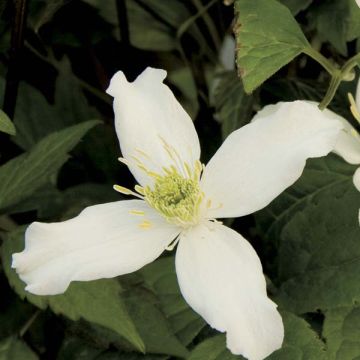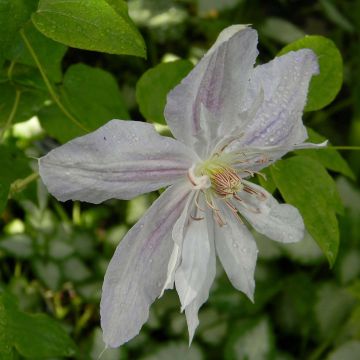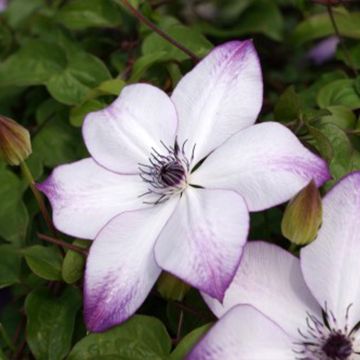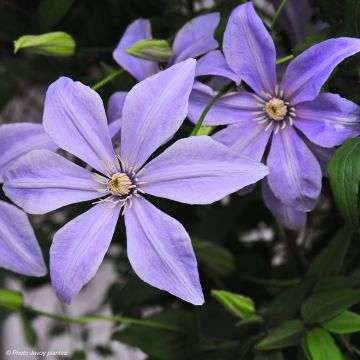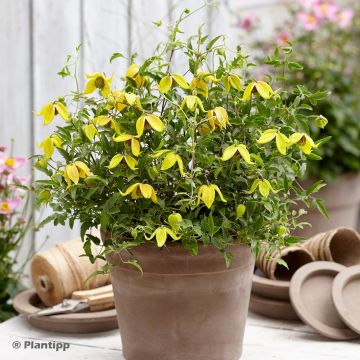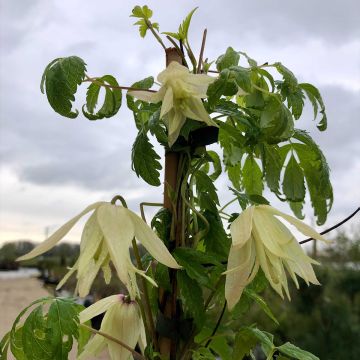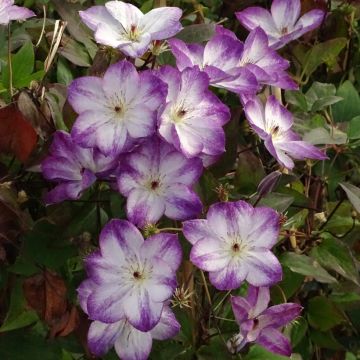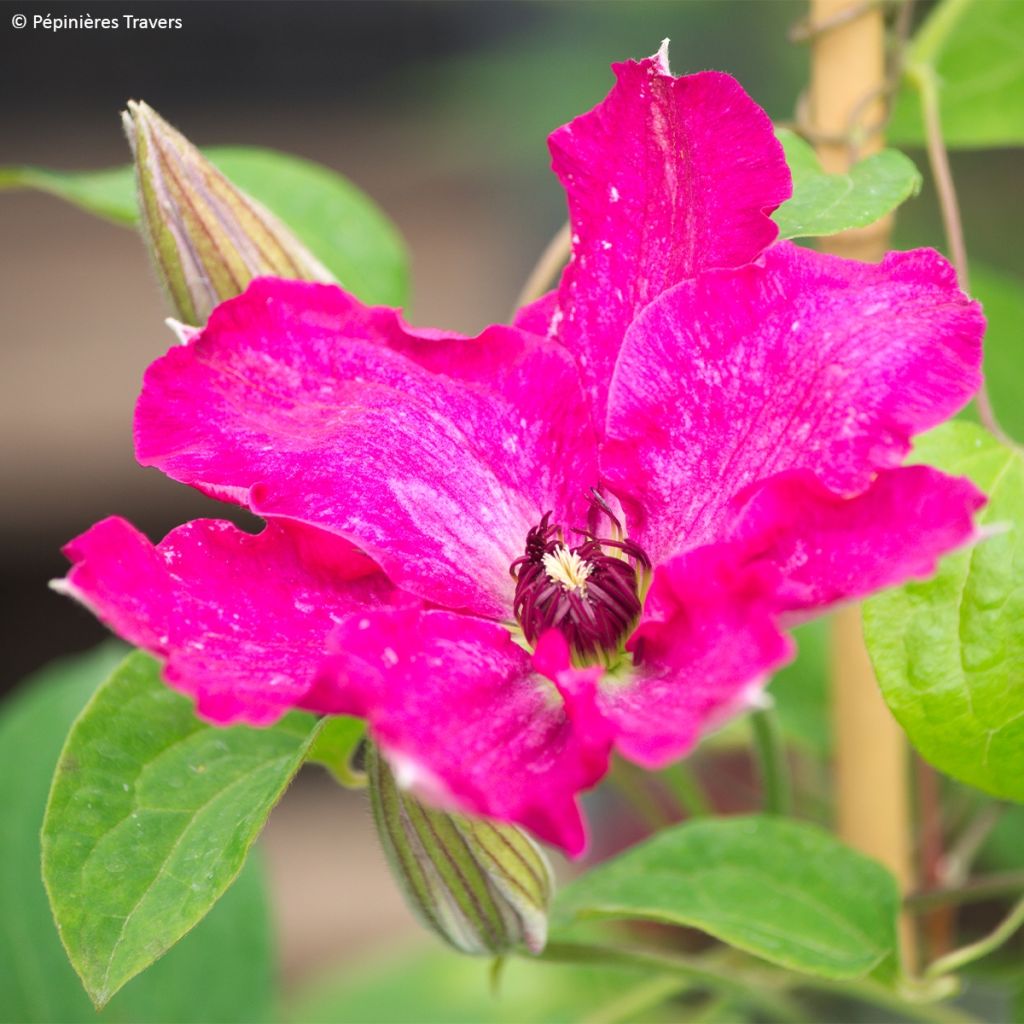

Clematis patens Viva Polonia
Clematis patens Viva Polonia
Clematis patens Viva Polonia
Why not try an alternative variety in stock?
View all →Order in the next for dispatch today!
Dispatch by letter from €3.90.
Delivery charge from €5.90 Oversize package delivery charge from €6.90.
Current delivery delay: 1 day.
More information
This item is not available in your country.
Schedule delivery date,
and select date in basket
This plant carries a 6 months recovery warranty
More information
We guarantee the quality of our plants for a full growing cycle, and will replace at our expense any plant that fails to recover under normal climatic and planting conditions.
From €5.90 for pickup delivery and €6.90 for home delivery
Express home delivery from €8.90.
Does this plant fit my garden?
Set up your Plantfit profile →
Description
Clematis 'Viva Polonia' has been named after the Polish flag due to its large red flowers bearing white star-shaped markings. These flowers can be seen from a distance. This compact variety blooms abundantly in spring, and then again on new shoots until late summer. It is both cheerful and easy to grow, and is not very susceptible to diseases. Like all clematis in the Patens group, it enjoys having its roots in cool soil and its head in the sun, whether in the ground or in a pot.
Clematis belong to the Ranunculaceae family. They can be found in both hemispheres, particularly in Europe, the Himalayas, China, Australia, and North and Central America. The 'Viva Polonia' variety is a horticultural hybrid created by the famous Polish breeder Szczepan Marczynski, and is part of the Patens group. It is a perfectly perennial and hardy climbing plant, reaching a height of about 2m (7ft) with a minimum spread of 1m (3ft).
This 'Viva Polonia' clematis bears single flowers that are 12 to 15cm (5 to 6in) in diameter. It blooms in May-June on the previous year's shoots, and then again on new shoots. They bloom in successive waves throughout summer. The upright flowers are either solitary or grouped in clusters and are particularly abundant. They have a rounded shape and consist of 6 wide petals that overlap at the base. Each bright pink-red petal is striated with white in the middle, which plunges into a pure white throat, creating a pattern that adds depth to the flower. The pinnate leaves, with oval, glabrous leaflets, are of the patens type and are fairly dark green. The deciduous foliage is absent in winter. This clematis clings to its support or host plant using petioles that have transformed into tendrils.
Plant your clematis alongside climbing roses or lianas to extend the flowering period of walls and pergolas until the end of summer. This genus is rich in diversity, with flowers of all colours, shapes, and sizes. Take advantage of their easy cultivation to give your garden, as well as your balcony, a romantic and bohemian touch. Just like sweet peas, morning glories, and nasturtiums, 'Viva Polonia' loves to weave through bushes. It thrives in a large pot, with its roots in the shade and its head in the sun.
Tips: light and regular watering, accompanied by mulching, helps maintain moisture at the plant's base. Pruning helps it to branch out and regain vigour after very cold winters. You can prune it in March, up to a height of 50cm (20in).
Report an error about the product description
Clematis patens Viva Polonia in pictures
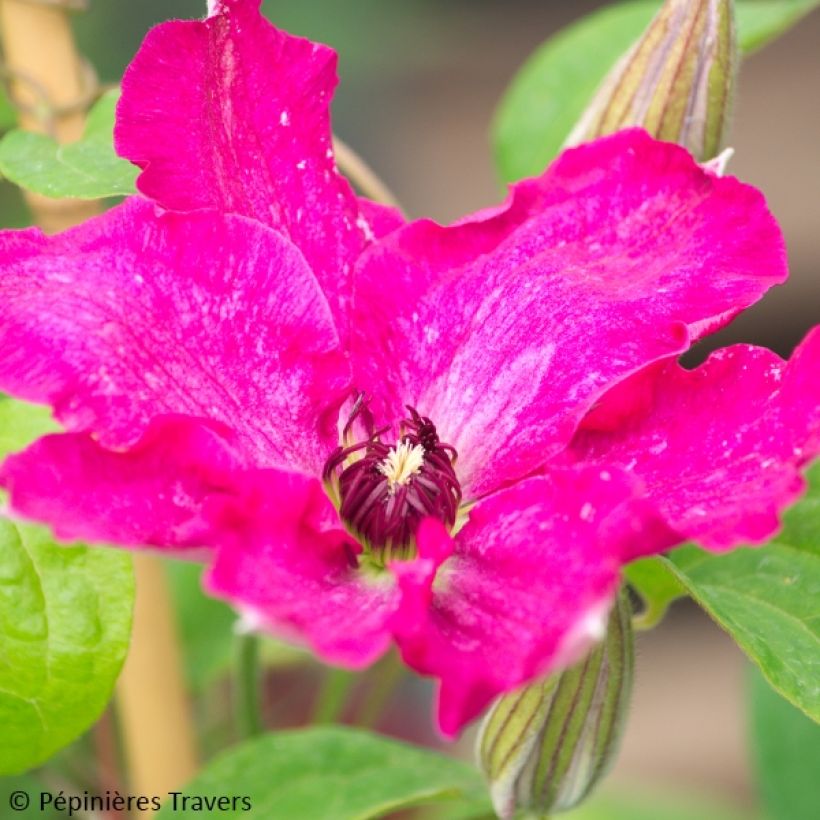

Plant habit
Flowering
Foliage
Botanical data
Clematis
patens
Viva Polonia
Ranunculaceae
Cultivar or hybrid
Other Clematis Patens
Planting and care
Clematis plants like to have their roots cool and their heads in the sun. In a sunny location, shade the base with a ground cover plant or a perennial geranium. Work the soil to a depth of 20cm (8in), lightened with good quality compost. Plant it by covering the root ball with 3cm (1in) of soil. Water regularly and generously during the first few weeks. Do not overwater, as stagnant water can lead to the development of fungus at the base of the plant
Clematis plants attach themselves using their tendrils. To promote their growth, provide them with a trellis or let them dress the trunk of a tree by placing a wire mesh against the trunk for the clematis to climb. Clematis plants also enjoy growing freely on neighbouring plants.
Planting period
Intended location
Care
This item has not been reviewed yet - be the first to leave a review about it.
Clematis
Haven't found what you were looking for?
Hardiness is the lowest winter temperature a plant can endure without suffering serious damage or even dying. However, hardiness is affected by location (a sheltered area, such as a patio), protection (winter cover) and soil type (hardiness is improved by well-drained soil).

Photo Sharing Terms & Conditions
In order to encourage gardeners to interact and share their experiences, Promesse de fleurs offers various media enabling content to be uploaded onto its Site - in particular via the ‘Photo sharing’ module.
The User agrees to refrain from:
- Posting any content that is illegal, prejudicial, insulting, racist, inciteful to hatred, revisionist, contrary to public decency, that infringes on privacy or on the privacy rights of third parties, in particular the publicity rights of persons and goods, intellectual property rights, or the right to privacy.
- Submitting content on behalf of a third party;
- Impersonate the identity of a third party and/or publish any personal information about a third party;
In general, the User undertakes to refrain from any unethical behaviour.
All Content (in particular text, comments, files, images, photos, videos, creative works, etc.), which may be subject to property or intellectual property rights, image or other private rights, shall remain the property of the User, subject to the limited rights granted by the terms of the licence granted by Promesse de fleurs as stated below. Users are at liberty to publish or not to publish such Content on the Site, notably via the ‘Photo Sharing’ facility, and accept that this Content shall be made public and freely accessible, notably on the Internet.
Users further acknowledge, undertake to have ,and guarantee that they hold all necessary rights and permissions to publish such material on the Site, in particular with regard to the legislation in force pertaining to any privacy, property, intellectual property, image, or contractual rights, or rights of any other nature. By publishing such Content on the Site, Users acknowledge accepting full liability as publishers of the Content within the meaning of the law, and grant Promesse de fleurs, free of charge, an inclusive, worldwide licence for the said Content for the entire duration of its publication, including all reproduction, representation, up/downloading, displaying, performing, transmission, and storage rights.
Users also grant permission for their name to be linked to the Content and accept that this link may not always be made available.
By engaging in posting material, Users consent to their Content becoming automatically accessible on the Internet, in particular on other sites and/or blogs and/or web pages of the Promesse de fleurs site, including in particular social pages and the Promesse de fleurs catalogue.
Users may secure the removal of entrusted content free of charge by issuing a simple request via our contact form.
The flowering period indicated on our website applies to countries and regions located in USDA zone 8 (France, the United Kingdom, Ireland, the Netherlands, etc.)
It will vary according to where you live:
- In zones 9 to 10 (Italy, Spain, Greece, etc.), flowering will occur about 2 to 4 weeks earlier.
- In zones 6 to 7 (Germany, Poland, Slovenia, and lower mountainous regions), flowering will be delayed by 2 to 3 weeks.
- In zone 5 (Central Europe, Scandinavia), blooming will be delayed by 3 to 5 weeks.
In temperate climates, pruning of spring-flowering shrubs (forsythia, spireas, etc.) should be done just after flowering.
Pruning of summer-flowering shrubs (Indian Lilac, Perovskia, etc.) can be done in winter or spring.
In cold regions as well as with frost-sensitive plants, avoid pruning too early when severe frosts may still occur.
The planting period indicated on our website applies to countries and regions located in USDA zone 8 (France, United Kingdom, Ireland, Netherlands).
It will vary according to where you live:
- In Mediterranean zones (Marseille, Madrid, Milan, etc.), autumn and winter are the best planting periods.
- In continental zones (Strasbourg, Munich, Vienna, etc.), delay planting by 2 to 3 weeks in spring and bring it forward by 2 to 4 weeks in autumn.
- In mountainous regions (the Alps, Pyrenees, Carpathians, etc.), it is best to plant in late spring (May-June) or late summer (August-September).
The harvesting period indicated on our website applies to countries and regions in USDA zone 8 (France, England, Ireland, the Netherlands).
In colder areas (Scandinavia, Poland, Austria...) fruit and vegetable harvests are likely to be delayed by 3-4 weeks.
In warmer areas (Italy, Spain, Greece, etc.), harvesting will probably take place earlier, depending on weather conditions.
The sowing periods indicated on our website apply to countries and regions within USDA Zone 8 (France, UK, Ireland, Netherlands).
In colder areas (Scandinavia, Poland, Austria...), delay any outdoor sowing by 3-4 weeks, or sow under glass.
In warmer climes (Italy, Spain, Greece, etc.), bring outdoor sowing forward by a few weeks.


































